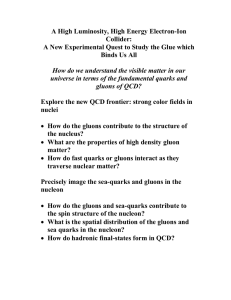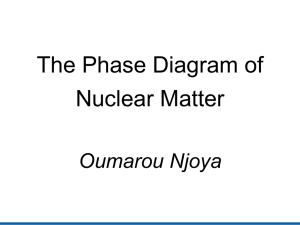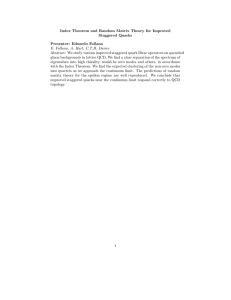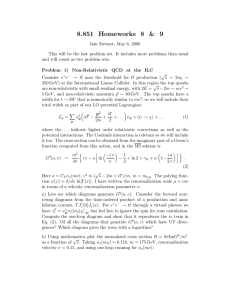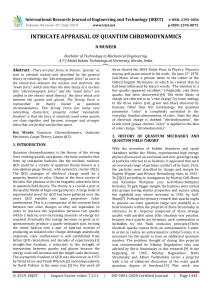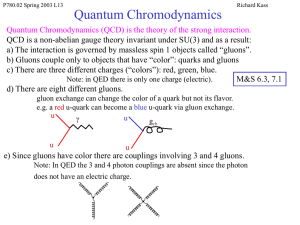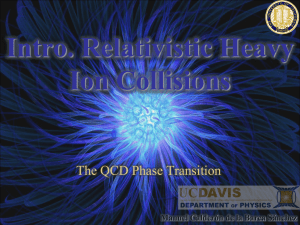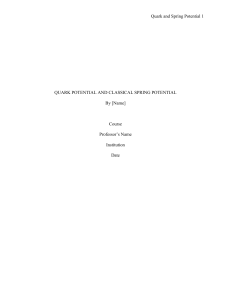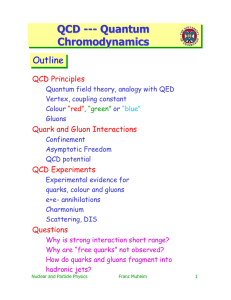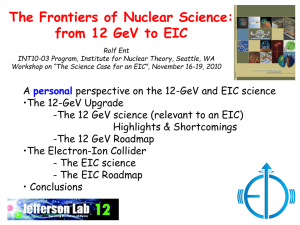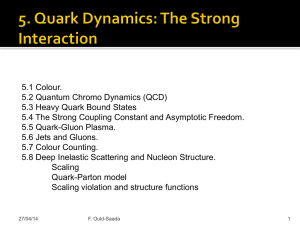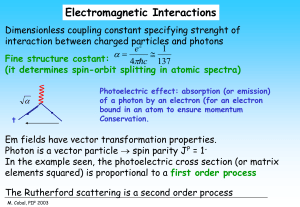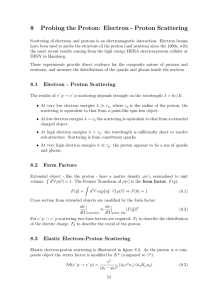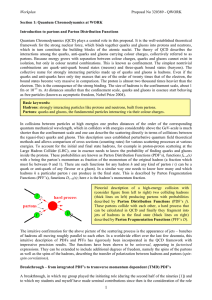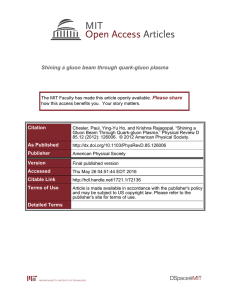Quark-Gluon Plasma Perfect Liquid From
advertisement
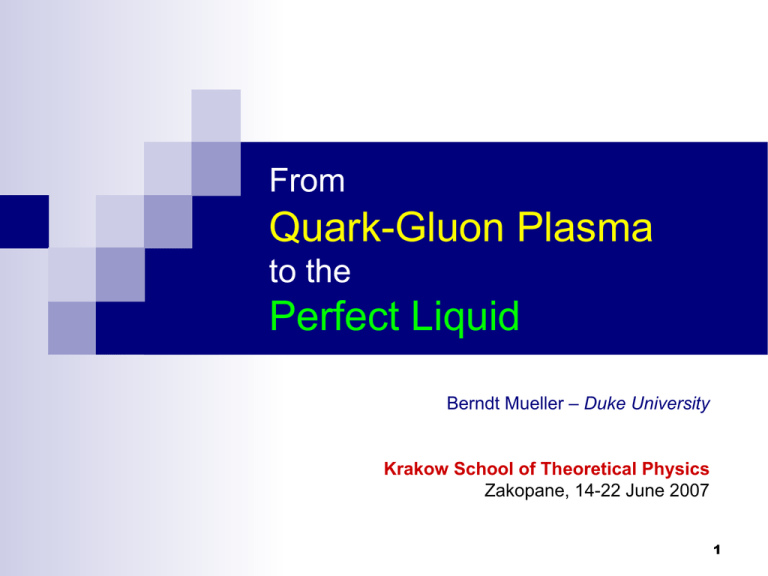
From Quark-Gluon Plasma to the Perfect Liquid Berndt Mueller – Duke University Krakow School of Theoretical Physics Zakopane, 14-22 June 2007 1 Part I Q uark-G luon P lasm a 2 Matter at extreme conditions • • Squeeze slowly → Cold, dense matter Squeeze fast → Hot, “dense” matter (1) is much more difficult to do than (2): Cold matter beyond nuclear matter density (ρB > ρ0 = 0.15 fm-3) exists only in the core of collapsed (neutron) stars. (2) Happened once: t < 20 µs after inflation. Can also be achieved by colliding nuclei at high energy. 30 years of history: Bevalac, AGS, SPS, RHIC → LHC. Goal: energy density ε » MN ρ0 = 0.14 GeV/fm3. 3 Quantum chromodynamics LQCD = − +ĺ +ĺ 1 4 ĺ a µν G G a a µν ć a a Ψγ ∂ µ + g ĺ Aµ t Ψ a č ř m f ΨΨ µ f f 4 Cosmic Connection 5 Degrees of freedom At extreme (energy) density, particle masses can be neglected relative to the kinetic energy: δ π Ε 2 2 ε = νň ωιτη Ε = π + µ 3 Ε /Τ (2π ) ε ± 1 2 ě7 / 8(fermions) π 4 ε =ν aT with a = 30 1 (bosons) 3 Quarks: ν = 2 × 2 × N C × N F = 12 N F Gluons: ν = 2 × ( N − 1) = 16 2 C 6 Hadrons or partons? If QCD had NF light quark flavors, there would be (NF2-1) nearly massless Goldstone bosons (“pions”): νπ = N −1 2 F For large NF the pions win out over quarks, but for NF=3 the quarks and gluons win out: → at high T matter is composed of a colored plasma of quarks and gluons, not of hadrons! 7 QCD phase diagram RHIC T Critical end point (?) QuarkGluon Tc ~ 170 MeV Plasma Chiral symmetry restored Hadronic matter 1st order line Chiral symmetry broken Nuclei Color superconductor Neutron stars µB 8 From hadrons to QGP ε= π2 30 νT 4 QGP = quark-gluon plasma ψψ ≈ 0 QCD equation of state from lattice QCD Hadron gas ψψ 0 9 Crossover of phases Susceptibilities peak at Tc, but do not diverge. Vacuum properties change smoothly, but rapidly → “crossover” A okietal.(N ature 2006) 10 A fuzzy transition? Fodoretal.(N ature 2006) 11 Quasi-particles in the QGP Physical excitation modes at high T are not elementary quarks and gluons, but “dressed” quarks and gluons: T Compton scattering on a thermal gluon! (k,ω ) Propagator of transversely polarized gluons 1 1 ćω k ω + k ů 2 D(k , ω ) = ω − k − ( gT ) ę1 − − ln 2 2čk ω ř ω−kű −1 2 2 → Effective mass of gluon: 1 m ľ ľ ľ→ gT 3 1 k →0 * mG ľ ľ ľ→ gT 2 * G k →0 12 Lattice - susceptibilities χ XY ∂2 = ln Z (T , µi ) = XY − X Y ∂µ X ∂µY XS ≈ ĺ xi si ni i R. Gavai & S. Gupta, hep-lat/0510044 C XS = # XS − X S 2 − S S 2 A .M ajum der pQGP 13 Color screening −Ń 2φ a = g ρGa (φ b ) + g ρQa (φ b ) Induced color density with µ = ( gT ) , 2 G 2 ρ a = − µ 2φ a NF µ = ( gT ) 2 6 2 Q φa Static color charge (heavy quark) generates screened potential α s −µr φ =t e r a a 14 Plasma two-stream instability r v r v 15 Turbulent color fields C olorcorrelation length M .Strickland,hep-ph/0511212 Tim e N onabelian Q uasiabelian N oise Length (z) 16 Quark masses H iggs 1000000 quark QCD mass Higgs mass 100000 field 10000 1000 100 Q uark 10 qq quark 1 u d s c b t qq condensate Q C D m ass disappears above T c: (partial)chiralsym m etry restoration 17 The QCD EoS (at µ=0) The precise value of Tc is still under debate: Tc = 170 ± 20 MeV with 20 - 30 MeV width. EoS near Tc is far from ideal ultrarelativistic gas! Sound velocity cs2 = ∂P/∂ε << 1/3. 18 Into the T-µB plane Tc ( µ B ) First order phase transition line Fodor& K atz (2001) Controls net baryon density 19 Is there a phase transition? Almost certainly: NOT 20 A triple point ? Fodoretal.hep-lat/0701022 21
